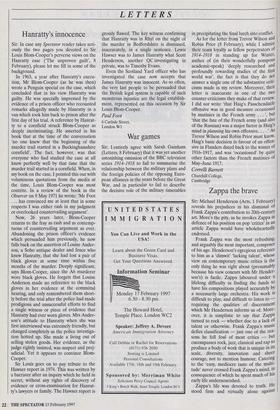LETTERS Hanratty's innocence
Sir: In case any Spectator reader takes seri- ously the two pages you devoted to Sir Louis Blom-Cooper's perverse views on the Hanratty case (The unproven guilt', 8 February), please let me fill in some of the background.
In 1963, a year after Hanratty's execu- tion, Mr Blom-Cooper (as he was then) wrote a Penguin special on the case, which concluded that in his view Hanratty was guilty. He was specially impressed by the evidence of a prison officer who recounted remarks allegedly made by Hanratty in a van which took him back to prison after the first day of his trial. A reference by Hanrat- ty to a cornfield struck Blom-Cooper as deeply incriminating. He asserted in his book that at the time of the conversation `no one knew that the beginning of the murder trail started in a Buckinghamshire cornfield'. The fact, however, was that everyone who had studied the case at all knew perfectly well by that time that the murder trail started in a cornfield. When, in my book on the case, I pointed this out with voluminous quotations from the media at the time, Louis Blom-Cooper was most contrite. In a review of the book in the Observer on 9 May 1971 he wrote: 'Mr Foot . has convinced me at least that in some respects I was either rash in my judgment or overlooked countervailing argument'.
Now, 26 years later, Blom-Cooper returns to the fray as rash and as contemp- tuous of countervailing argument as ever. Abandoning the prison officer's evidence which persuaded him previously, he now falls back on the assertion of Louise Ander- son, a Soho antique dealer and fence who knew Hanratty, that she had lost a pair of black gloves at some time within five months of the murder. Deeply significant, says Blom-Cooper, since the A6 murderer wore black gloves. He forgets that Louise Anderson made no reference to the black gloves in her evidence at the committal hearing, and only remembered them short- ly before the trial after the police had made prodigious and unsuccessful efforts to find a single witness or piece of evidence that Hanratty had ever worn gloves. Mrs Ander- son's attitude to Hanratty when she was first interviewed was extremely friendly, but changed completely as the police investiga- tion hotted up. She made a living out of selling stolen goods. Her evidence, as the judge rightly insisted, was suspect and prej- udicial. Yet it appears to convince Blom- Cooper.
Sir Louis goes on to pay tribute to the Hawser report in 1974. This was written by a barrister after an inquiry which he held in secret, without any rights of discovery of evidence or cross-examination for Hanrat- ty's lawyers or family. The Hawser report is grossly flawed. The key witness confirming that Hanratty was in Rhyl on the night of the murder in Bedfordshire is dismissed, inaccurately, in a single sentence. Lewis Hawser was to James Hanratty what Scott Henderson, another QC investigating in private, was to Timothy Evans.
Even the Scotland Yard officer who has investigated the case now accepts that James Hanratty was innocent. As so often, the very last people to be persuaded that the British legal system is capable of such monstrous injustice are the legal establish- ment, represented on this occasion by Sir Louis Blom-Cooper.
Paul Foot
6 Carlisle Street, London W1


























































 Previous page
Previous page